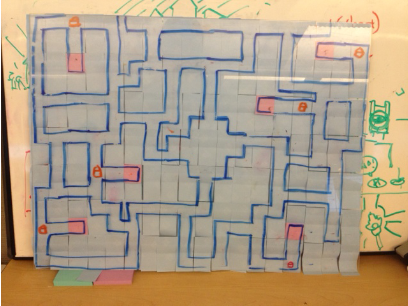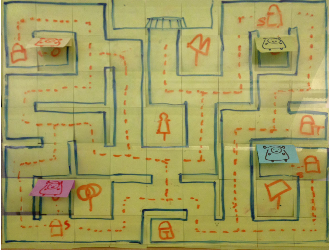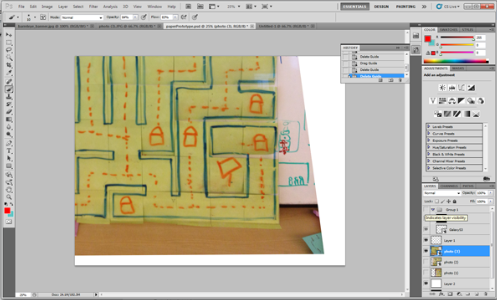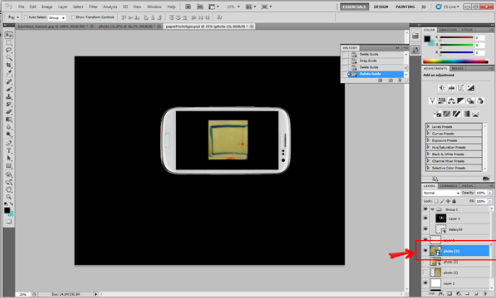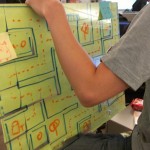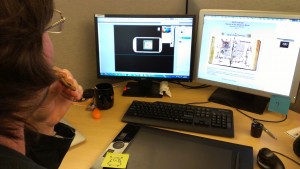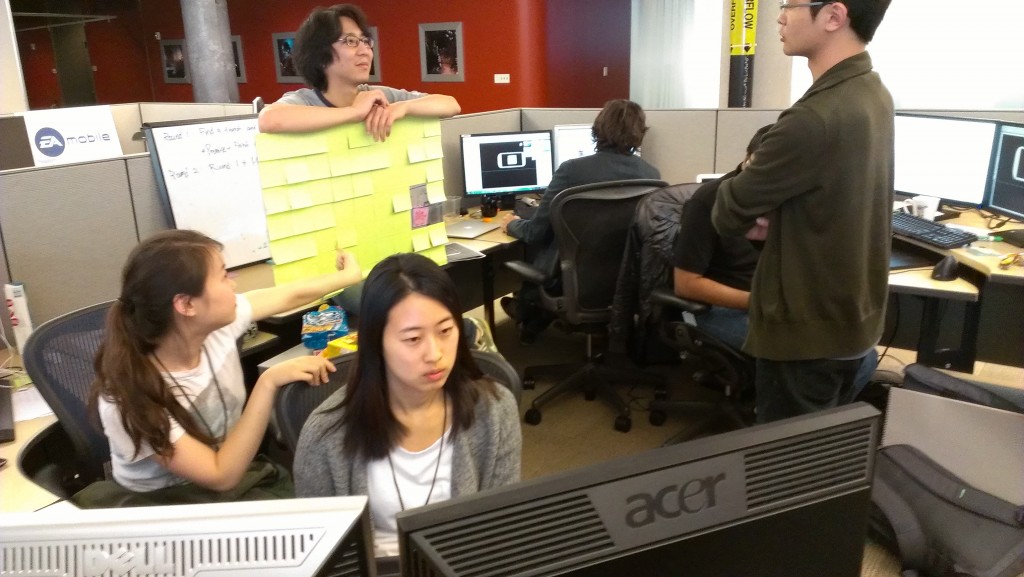On Friday September 14th we tested out a “paper prototype” using an ingenious system devised by our level designer, Jaewan Park. What follows is his description of the prototype and the playtest itself. -Brad
Main Screen – Transparent Acrylic
We used a transparent acrylic board as the main screen. On the back of the board I drew a map with a marker, and on the other side I hid the map with post-its so that players cannot see the entire map at the beginning.
Before we playtested, I got feedback from Rich [Hilleman] that the map is probably too large for a two-minute experience. So I scaled it down to about a quarter of the original map size.
As gamemaster, I move paper characters manually on the back side of the board. The players don’t see their characters on the front unless they have a torch, in which case I move the post-its to reveal that part of the map.
Individual Screen – Workstation with Photoshop
The players each had an individual workstation to control their characters. I placed two layers in Photoshop.
First, I placed a photo the dungeon map.
Second, I put a fake cell phone mask on top of the map layer.
The player can control the map layer using the arrow keys on the keyboard, allowing them to simulate movement through the maze. We played the prototype as a turn-based game, and whenever each player moved their character I (as game master) would update the main screen as well.
Objectives
My goals with the paper prototype were:
- First, to design a map in a short amount of time.
- Second, to let us iterate quickly and solve problems through iteration.
- Third, I expected the total time of the paper prototype test would be about eight times more than a digital prototype. We used this assumption to estimate how long it would take players to find one another and advance to the boss room.
I was able to design the map quickly because I did not rely on any other technology, so I only focused on the design. It was easy to iterate with the paper prototype, but it had the disadvantage that it took a very long time to finish a playtest. Therefore, we are moving on to digital prototyping because that technology is almost ready.
I was proud of my own work on this prototype because I’ve never made a paper prototype before so this was unknown territory. I learned a lot about map design in a short amount of time.
Playtest Results
Here are some notes from our playtest:
Round 0 – Rich points out that the map is too big. We redesign the map.
Round 1 – We have four playtesters. Failure. Players spent five minutes wandering around before I discovered a problem with the map – it needed to be mirrored on the computers, since the players were seeing the back of the acrylic screen instead of the front. We took a break and I corrected the problem.
Round 2 – We have three players, and corrected the flipped-board issue. Having no torch makes people frustrated. Players spent about five minutes and they did not find any treasure boxes at all. There were 10 treasure boxes on the board, but it still took a long time. We take a break and I updated the map so that all players are guaranteed to find an item within their first few steps.
Round 3 – One person playtest. Bang! The player found the boss room in 8 moves. What?
Round 4 – Two players, on a fixed map. The players were given one torch at the beginning of the game and asked to find each other. They looked at the main screen (acrylic board) right away and checked back frequently. They reported the experience was interesting.
General feedback
- Sometimes it is frustrating because we have to wait a long time between turns, and it feels like there are not many options of different paths to follow.
- Maybe having rooms instead of just hallways would give more variation to players in the dungeon.
- On the other hand, maybe we should just consider changing the number of intersections in our maze to adjust its difficulty/variety.
- It takes too much time to move with the paper prototype, which makes it hard to judge how much time the overall game will take.

